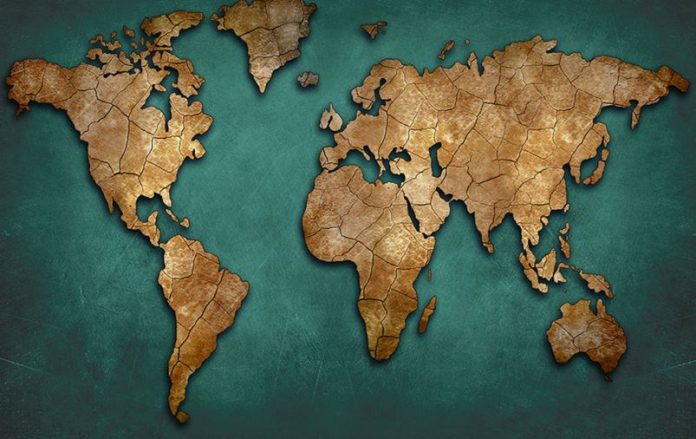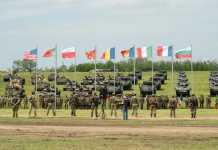The U.S. has long enjoyed peace in its own hemisphere. Shooting wars in the Americas are vanishingly few. Invasion directly threatens no part of U.S. territory. Those desperately intense moments following the rare penetrations of its geographical veil, a Pearl Harbor or a 9/11, reveal how firmly fixed is the American belief that danger lies oceans away. This quiescence makes threats to the U.S. homeland, not just the most unexpected, but also the most critical dangers to national security.
Unfortunately, today’s world of growing conflict implies growing uncertainty. As one spreads, the other increases. Putin’s invasion of Ukraine raises the specter of tomorrow’s contagion. Putin is unlikely to be satisfied after a single meal. He already seems to gaze hungrily at Moldova.[1] Nor is Putin alone in his ambition. China’s appetite is well-known. While its designs in Taiwan are most infamous, they are far from exceptional.[2]
These crucibles are primarily neighborhood squabbles, conflicts in what Russians call the “near abroad,” consisting of neighbors in Eastern Europe and Central Asia. Far removed, but no less fraught, is what I call their “far abroad,” the Atlanticist powers of Western Europe and the Americas where conflict, though less immediate, is no less pressing.[3] While China itself doesn’t use this dichotomy, it suits its operations as well.
While one should always be skeptical of neat dichotomies, this one is powerful and used not just by Russia. Al-Qaeda has near and far enemies, for example.[4] Its utility lies in cleaving the world into areas subject to direct and indirect influence.
Russia’s attack on Ukraine dramatically expands the possibilities of intervention in any nation’s near abroad, reintroducing the potential for a military invasion, the most direct influence on neighbors. While the renewed possibility of invasion doesn’t change much superficially in the far abroad, the near and far abroad are neither as isolated as they seem. Alliance and competition create networks where events far removed from theaters of action impact opportunities in the immediate military and diplomatic operations. This fact makes it impossible for revanchist powers to focus on near enemies to the exclusion of far.
The U.S. is a far abroad enemy for Russia and China. While America impacts the operations of both, it is geographically distant. The U.S. will nevertheless play important roles in any near-abroad operation due to its unique logistical prowess, enabling force projection to any part of the globe, and its central position within major alliances. The dual position of the U.S. means powers have a choice in opposing American actions: they can either counter them in their own neighborhoods directly or counter them indirectly.
Far-abroad operations have a number of advantages. While near-abroad actions are almost impossible to execute fully without invoking hostilities, powers can conduct operations in the far abroad indirectly using proxies, sanctions, cyber-attacks, and other actions that exist below the threshold of war. This wider range of activities enables weaker countries to attack stronger ones since these asymmetric campaigns rely on operations where the results often exceed the resources expended while enabling deniability. Far-abroad operations are also well-practiced. Russia, in particular, has employed them since its Revolution, initially under the COMINTERN and later under its own auspices.
Hybrid War, What Is It Good For?
Russian hybrid war and Chinese gray zone activities perfectly exploit indirect, far-abroad asymmetries. They require minimal resources, can be executed through allies, and are easily deniable.[5] These activities, though differently named, share goals and tactics. Their goals require operating below the threshold of outright war to obtain strategic objectives in the face of opposition. Their tactics exploit deniability, manipulation, and dissension to achieve limited objectives that might otherwise require open warfare.
The primary requirement for hybrid war is turmoil. Fortunately for its adversaries, the U.S. has plenty, some of which they stoke.[6] Turmoil is essential because, absent conflict, national solidarity is too strong for effective information operations. Kinetic irregular warfare, i.e. exploiting gangs and other radical/criminal organizations, will likewise fail without internal strife, since such exploitation requires internal violence to provide access, pretext, and deniability.[7]
The primary combatant also needs a proxy network to realize its operations. Russia typically uses other countries (e.g., Belarus), or private organizations (e.g., the Wagner Group).[8] China exploits its fishing fleet, maritime militia, and other state-affiliated companies/organizations.[9] These provide force projection without formally implicating the country employing them and, due to their reduced footprint, operate at levels below open hostilities that are more easily maintained logistically.
Given its history in the Cold War and earlier, as well as its recent military revanchism, Russia poses a larger hybrid threat than China, so our analysis begins here and then considers how it could combine forces to wage a general campaign against the U.S. and its allies in the Americas.
Rockin’ in the Free World
The primary requirement of hybrid war is entrée. Russia has several inroads into Latin America.[10] The staunchest of Russia’s allies is Cuba.[11] During the Cold War, Cuba even supplied arms and personnel for Soviet campaigns in Africa.[12] It is a potential post for Russian military forces today.[13] Venezuela, another key ally, may host Russian military forces.[14] Daniel Ortega in Nicaragua has supported Russian-backed authoritarians since his Marxist Revolutionary days.[15] Argentina recently offered to serve as Putin’s “gateway to the Americas.” Russia cultivates these and other future possibilities.[16]
Latin American politics has changed dramatically in the past decade. While elections in the last ten years have launched conservatives who are often pro-U.S. into power, this trend reversed last year.[17] Being leftist in Latin America does not inherently mean being anti-U.S., but leftists tend towards skepticism about the U.S. and alignment with its adversaries.[18]
Vladimir Putin and Nicolas Maduro, Presidents of Russia and Venezuela, in Moscow in 2013 (Kremlin)
These changes have threatened democracy.[19] Ortega’s re-election and the failed resistance against Nicolás Maduro in Venezuela show authoritarianism is far from retreat.[20] Peru is experiencing a constitutional crisis with demonstrations serious enough for its president to invoke curfews to maintain power.[21] Jair Bolsonaro in Brazil, while rightist and once pro-U.S., isn’t pro-democracy.[22] He, along with Mexico’s Andrés Manuel López Obrador, have taken tepid positions on Ukraine while courting authoritarian rule at home.[23]
Despite these setbacks for America, Russia is sustaining its regional image. Many countries that condemned the American 9/11 Afghanistan operation stand silent on Russia’s invasion of Ukraine.[24] In the UN, Cuba, Nicaragua and Bolivia voted against expelling Russia from the Human Rights Council, while Brazil, Mexico, El Salvador, Barbados, Belize, and Guyana abstained.[25] Some, like Cuba, Nicaragua and Venezuela, have even voiced occasional support for Russia’s incursion.[26]
Russia’s adept manipulation of generic authoritarian postures, adjusting to fit whatever ideological stance counters its adversaries, allows it to twist any conflict to its advantage. Such flexibility creates a ripe environment for information operations. [27] Russia can count on a wide Latin American audience. RT en Español, the Spanish version of the official Russian information machine, is the third most shared site on Spanish-language Twitter for information about Russia.[28]
Russia can exploit several factors beyond the information domain. Most concerning, given the events in the Ukraine, are border disputes.[29] While currently peaceful, Latin American nations maintain large militaries.[30] These forces do not exist merely for counter-narcotics. They exist to defend against other states and preserve internal unity. Latin American warfare in the 19th and early 20th centuries demonstrates this reality.[31]
Potential for war exists today.[32] Active border disputes involve Guyana and Venezuela, with Venezuela claiming an astounding 75% of Guyana.[33] Venezuela and Colombia have both recently deployed troops to their respective borders.[34] Latent conflicts involve Bolivia and Chile, Colombia and Nicaragua, Brazil and Uruguay, among others.[35] Certain countries, like Chile, experience internal conflict rising to levels of armed rebellion.[36] While these disputes are overwhelmingly peaceful and parties prefer the International Court of Justice (ICJ) to open war, conflict occasionally erupts (e.g., the Falklands War in 1982, the Cenepa War between Ecuador and Peru in 1995), imperiling institutional solutions against future ills.[37]
Latin American countries’ use of the International Court of Justice testifies to the potential of international law and the stability of the post-war order.[38] Currently ,the U.S. exercises general hegemonic power through alliances in the region, convincing parties that individual military action is futile. This power prevents any one country from starting a cycle of invasion and counter-invasion that would collapse the pax Americana.[39] This conviction bolsters resolution-mechanisms like the International Court of Justice, which creates a virtuous circle based on overwhelming American/allied military force and effective international institutions. This stability is a state of mind as much as a military reality, however. If several wars erupted simultaneously, the U.S. and its allies could not stop them all. While multiple conflicts are unlikely to erupt on their own, the encouragement of outside powers and alternative alliances could create this possibility.
Border wars are chiefly dangerous for intensifying pre-existing strains, which can be destabilizing. One need only consider the tight relationship between guerrillas and drug production to see conflict’s third-order effects.[40] Military activity in the U.S.’s backyard breeds regional instability that also requires force reallocation to the homeland from abroad, weakening U.S. ability to project into more distant regions and thinning U.S. global defense-in-depth.
Putin adeptly manipulates demographic factors to make war, including militarizing ethnic groups and refugees.[41] Waves of migrants, already destabilizing to U.S. politics, pose another homeland threat. Currently, Russia colludes with Belarus to weaponize migrants’ entrance into the EU as part of hybrid warfare.[42] Putin likewise manipulates refugee movements to justify and intensify Ukrainian operations.[43]
Putin might duplicate this activity in the Americas. Putin’s ally Ortega, president of Nicaragua, a major source of refugees, could facilitate destabilization as Belarus has done to Poland and the EU.[44] Russia would likely compound this problem by providing military training to MS-13 and other gangs, sending them to execute guerrilla tactics on American soil, duplicating strategies conducted in the Crimea through gangs like the Night Wolves.[45] The Mexican experience with military-trained gangsters demonstrates how destructive well-trained criminal organizations are.[46]
Russia’s potential for increased presence in the Americas has serious potential geo-economic impacts.[47] Territorial expansion gains Russia several benefits. The primary one is increasing the number of countries operating outside American economic influence. When this number reaches a threshold, Russia will be able to create an independent financial system to avoid dollar-based sanctions. The power of the Russian economic influence is already on full display as Brazil and other countries indicate their reliance on Russian products such as fertilizer for their avoidance of condemnation over its invasion of Ukraine.[48]
By consolidating its international economic reach, Russia could ultimately create a community of nations operating outside American-dominated economic institutions, be they financial (like the SWIFT system that empowers American sanctions) or geo-political (like the International Monetary Fund), and subject to dominance by Russia and its major ally, China.[49] This power will enable them to extract from others, enriching Russia more than military relations such as arms sales, Russia’s primary path to gain military wealth and influence.[50]
One Is the Loneliest Number
Russia cannot accomplish the above alone. It needs help from regional allies, which provide entrée into the American chessboard, and powerful nations willing to supply technical skills, arms, and strategic support. China and Iran are foremost in advancing Russian efforts.
Despite the uneasy alliance of China and Iran with Russia, this triple axis wishes to expand at America’s expense.[51] None can succeed alone. Their unity of opposition thus necessitates unity in opposition, helping concentrate their efforts. Latin America is an excellent focus. While the triple axis competes elsewhere, having overlapping spheres of influence in Eurasia, these pressures are absent from the Americas, where none has a natural area of influence, but each can operate to attack their common enemy.[52]
Though a relatively minor power on the global stage, Iran allied with China or Russia exacerbates the dangers from either country.[53] Worryingly, Iran has an outsized presence in Latin America, enjoying a particularly close relationship with Venezuela.[54] The Quds Force, operational in Venezuela, has expeditionary capacity and military success in Syria.[55] It has experience fighting Americans, having provided most of the explosively formed penetrators/projectiles (EFPs) that decimated Americans in Iraq, and supports the most effective Iraqi Shi’i insurgent militias.[56] The Quds Force is supplemented by the Iranian proxy and international drug-dealer, Hezbollah, in Venezuela.[57] While Iran’s bark in the region is much larger than its bite, with the U.S. successfully preventing Iranian military assets from visiting Venezuela, in the presence of allies, it could easily conduct malign operations.[58]
China is particularly threatening. It is Russia’s largest military partner. The two have close military cooperation, showing interoperability.[59] China has extensive connections throughout Latin America via its Belt and Road Initiative, with two potential military-use facilities in the region: a brand-new port in Peru and a paramilitary space facility in Argentina.[60]
Argentina exemplifies why China and Russia can draw in Latin American countries. Argentina blames its economic instabilities on the American-led economic order, particularly the International Monetary Fund, which has seen Argentina default on debt payments.[61] Argentina also has the most intense territorial contest on the continent over the Falklands, which puts it in opposition to a close U.S. ally, Britain.
China and Russia can help on both fronts. With new development initiatives, Argentina gains alternative financing that promises not to exact repayment via restructuring, instead carving up national sovereignty.[62] China and Russia also promise Argentina military support, enforcing its claims over the Falklands, which includes a potential Chinese naval base in Equatorial Guinea, 3,000 miles closer to the Falklands than the British at 8,000 miles away.[63] This allows Chinese ships to reach Argentina more quickly than the British, and since it lies athwart the path British vessels must steam, it allows the Chinese to intervene in or interfere with a British mission. This concern is particularly pressing since the logistical difficulties created by the Britain-Falkland distance presented the greatest difficulty to Britain’s defense of the islands in 1982.[64]
The potential impact of an Argentine invasion of the Falklands is significant. Even a little military assistance could enable Argentina to invade the Falklands. Even if it failed once again, the impact of an invasion on the British Navy would be significant.[65] If the invasion happened during wartime, the British would be forced either to remain engaged elsewhere and lose the Falklands or withdraw much or most of their support from another theater and risk failure there. This loss for an American-British alliance in terms of power and morale would be potentially devastating.
You Can’t Always Get What You Want, but If You Try Sometime You Get What You Need
The above is a potpourri of potential hostile operations. Not every scenario will happen. Not every scenario directly affects the U.S. Not every scenario has to happen to decrease U.S. domestic security greatly, however. Since instability breeds instability, the compounding potential of these problems is dangerous as the occurrence of any one event makes the others more likely. The tempo will also be under the control of the triple-axis. They could engage in low-level operations affecting a limited area or a greater operation attacking the U.S. itself. This would turn the American virtuous circle of security into a vicious downward spiral.
Given the relative inattention of the U.S. to Latin America this century, it may find itself too far behind to prevent these aggressions completely, leaving its enemies with an irremovable bridgehead.[66] No longer will Europe and Asia’s problems be just a European or Asian concern. Everything could become a threat to domestic security.
These facts should be a wake-up call for American diplomats and service members, who must think carefully and critically about building new alliances and strengthening old ones to ensure security, not just for world order, but potentially for their own home.





